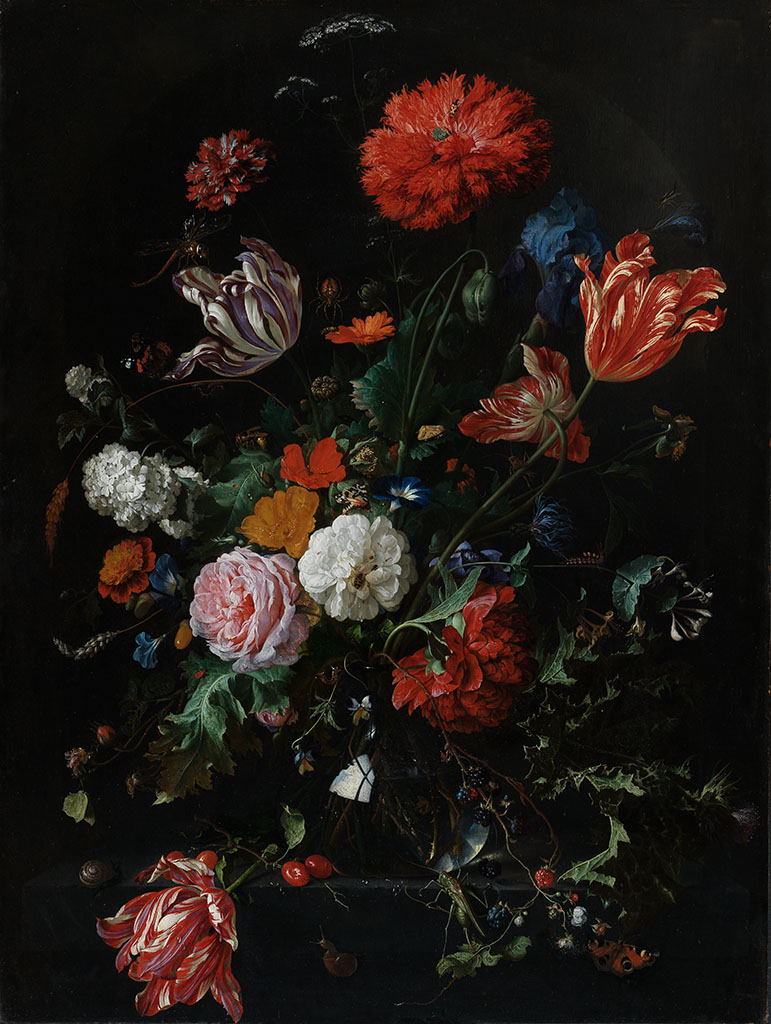Look and Think activities should take 5 -10 minutes.
Do activities might take longer depending on the task and how creative you are feeling!
Flowers in a glass vase by Jan Davidsz de Heem
Dutch, 1606-1684, Oil on wooden panel
Height 93.2 cm x width 69.6 cm, 1487
Look
Set a timer for 3 minutes.
How many insects can you spot?
Now watch our story about this painting, Vanessa the Lost Butterfly, below.
Think
Can you name all the insects?
Now try the same with the flowers!
Do
Can you make a still life arrangement of your own?
You can use real fruit and flowers, or other objects that you can find or make.

Henrietta Ward, our Assistant Keeper of Paintings Drawings and Prints, helped us to identify the wildlife hidden in this painting.
We counted 20 insects:
Peacock butterfly, Red Admiral butterfly, Garden Tiger moth, Brimstone butterfy, Garden snail, Burgundy snail, Comma caterpillar, Scarlet Lily beetle, Milkweed beetle, Hornet (under white and purple tulip), Ladybird, ant, dragonfly, spider, yellow bug (perhaps fruit fly or small horse fly?), crane fly, cricket (x 2- a big one at the bottom and one on the stem of a tulip as if looking out at us)
And 33 individual flowers:
carnation, tulip, columbine, pansies, double poppy, African marigold, marigold, peony, honeysuckle, snowball viburnum, iris, rose, viola, centaura, thistle, convolvulus (morning glory), anemone, cow parsley and Rutpela maculate known as the spotted longhorn on the poppy at the top. There are also branches of blackberries, crab apples, sheaths of wheat and an acorn.
There may well be others, it is very hard to identify them all!
How would you go about painting a composition like this? Where would you start and what would the major challenges be of painting a floral arrangement like this? Are all the flowers in season at the same time? Some of these plants are very rare and expensive and wouldn’t last for long. How would you stop the insects running away?
It’s very hard to believe that this floral arrangement was in front of the artist when he painted it. De Heem would have built up the composition over some time, as and when the flowers became available. He would also have worked from earlier drawings and sketches.
Jan Davidsz. de Heem (1606-84) was born in Utrecht, just south of Amsterdam in the Netherlands and became one of the most outstanding still-life painters of his time. His style was so popular he could hardly finish a painting before he was asked to start another.
This was painted at a pivotal time in Dutch History. Following a long and bloody war with Catholic Spain who had ruled for 100 years, the new Republic of the Netherlands gained independence in 1648. This break from the Catholic church saw the Dutch reinvent their own unique national identity with art using genre paintings like still life, seascapes, portraits and scenes of domestic life.
De Heems’ minutely painted floral arrangements are crawling with insects, which must have delighted and surprised the collectors for whom these paintings were intended; the closer you look, the more creatures you see! He painted this in the 1660s when there was a growing interest in the natural world, as people set sail to explore and collect specimens from around the world.
Today, flowers from around the world are readily available in a rainbow of colours at supermarkets and florists- but once they were considered priceless rarities and showed a country’s wealth and ability to trade outside of its borders. Some of these flowers, tulips in particular, were so expensive that it was cheaper to buy a painting of them than display the real things in your home. Another advantage of a painting is that it will not wilt or die like a real flower. During the ‘Tulip Mania’ boom that peaked between 1633- 37, people were in such a frenzy to buy and sell varieties of brightly coloured tulip bulbs ( originally introduced from Turkey) a single bulb could change hands for 4,400 guilders. Less than half that amount could have bought you several horses and sheep at the time.
As well as being a still life painting , paintings often carried hidden moral messages known as ‘Vanitas’-reminding us that nothing lasts forever. Perhaps in this painting we are reminded that life is delicate and fades like a flower. We can only guess but there may also be a more obvious link to Christianity as the painter has chosen to capture a cross reflected from a window in the clear water vase.
You can find out more about de Heem on ArtUK.org
Download this Look Think Do: Flowers in a glass vase as a PDF or a Word document.
This version is great for little ones. It includes a colouring sheet.